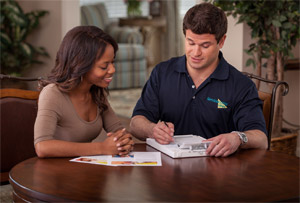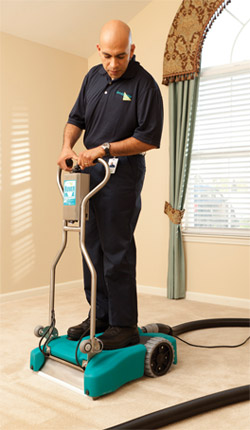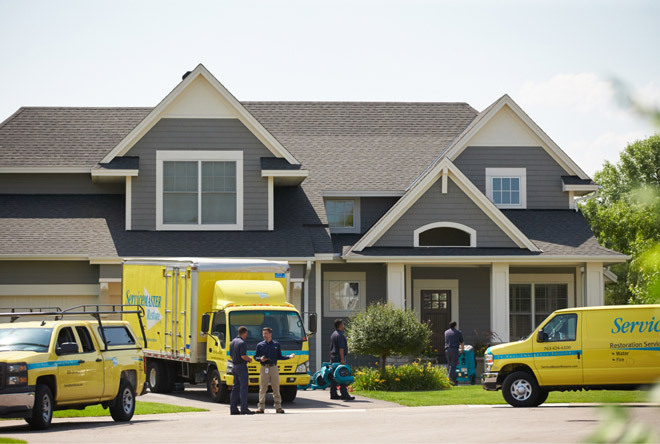Residential Water Damage Cleanup

NO MATTER THE CHALLENGE, OUR TEAM IS READY.
ServiceMaster Clean is a highly reputable, licensed, insured and endorsed water damage service provider. In addition to our years of experience, our qualified technicians have completed advanced training in water mitigation, dehumidification systems, mold remediation and corrosion control. They also seek continuing education to learn about new techniques and equipment to better serve you in your time of need.
UNDERSTANDING THE WATER MITGATION PROCESS
First we identify the source of the problem and the scope of the damage.
A thorough examination using specialized moisture-detection meters, probes
and sensors to determine the extent of the damage enables us to form the
most effective plan for returning your property to normal as quickly as
possible. Our inspection may include identifying possible hoses or other
parts that may have been the cause, tagging these for the insurance company
and providing photo documentation.
In flooding, water typically spreads out and flows through the path of
least resistance, especially toward substructures and lower floors. Porous
materials, whether wood, sheetrock or other building materials, will soak
up the water, which can even travel upward. The resulting effects can
include discoloration, swelling, broken adhesive bonds, delamination (flooring
separation), warping and overall breakdown of building materials that
make up your property. The more time that elapses before treatment, the
greater the damage. Even if the water evaporates unassisted, it can cause
damage to ceilings, walls and contents.
The information below is general in nature and aid to you in understanding the processes and procedures in restoring your property and may require up to three phases before completion:
Phase One: Emergency Service
Upon our arrival, a Statement of Authorization will need to be signed before work can begin. A ServiceMaster Clean trained technician will begin by determining if your carpet is salvageable and if the carpet can be dried in place. If so, we will extract as much water as possible. High-velocity air movers and dehumidifiers will be set up to dry the carpet and subfloor quickly. Equipment must be left on for the designated amount of time to ensure proper drying. The carpet may need to be treated to inhibit microbial growth. If the pad cannot be dried in place, we will detach the carpet from the tack strip and removal the wet padding to expedite the dying process. A pad sample will be taken back to our office to be matched and ordered for the reinstallation. If your carpet is deemed unsalvageable, the technician may advise removing both the pad and the carpet.
Job Site Inspections
It will be necessary for us to have access to your property during business hours throughout the drying process in order to properly monitor the temperature, humidity, and our equipment. Please work with our office on your preferred method for reentry to your property so we can properly monitor the drying process.
Phase Two: Reinstallation/Cleaning
When carpet can be successfully restored, we may need to install new pad and reinstall the carpet. Reinstallation includes restretching, reattaching the tack strip, seam repair and threshold repair and/or replacement. After the reinstallation, carpet is cleaned and deodorized. When the carpet and pad can be successfully restored through in-place drying, the carpet will still need to be cleaned and deodorized. During this phase, any upholstery or other damaged furnishings will be cleaned. If equipment is still present, the technical will remove it at this time.
Phase Three: Structural Repairs
If applicable, after the drying process is complete, structural damage is assessed and the repair phase can begin. At this time, drywall, ceilings and floors will be repaired. If carpet cannot be salvaged, new carpet and pad will be installed. It may be appropriate to complete structural repairs before reinstallation and cleaning.
AT SERVICEMASTER RESTORE, WE UNDERSTAND THE DAMAGE GOES BELOW THE SURFACE.
ServiceMaster Restore methodology meets or exceeds industry standards, adhering to criteria established by the institute of Inspection Cleaning and Restoration Certification (IICRC). Many of our products are proprietary and developed exclusively for use by ServiceMaster Restore. We never stop seeking new technologies and methods that allow us to provide better customer service while lowering overall claim severity. From our fast response to our proven expertise to our ongoing communication, we are committed to restoring your peace of mind. Follow these steps to help keep damage to a minimum.
What To Do In Case Of Water Damage?
- Damage from water and bacteria growth can begin within hours. Call for professional help.
- Remove as much water as possible by mopping and blotting.
- Remove wet area rugs or other floor coverings not permanently attached. Do not attempt to start removing your wall-to-wall carpet.
- Lift draperies off the floor, loop through a coat hanger and place it on the drapery rod.
- Wipe furniture, prop up wet furniture cushions for even drying and place aluminum foil under furniture legs.
- Move photos, paintings and art objectives to a safe, dry location.
- Do not remove books from shelves. Instead, pack them tightly to prevent warping of pages until a restoration professional can begin this specialized drying.
- Open drawers, closets and cabinet doors to enhance drying.
- What Not To Do In Case of Water Damage: (drop down menu)
- Do not enter a room with standing water until electricity has been turned off.
- Do not use a regular household vacuum to remove water.
- Do not lift tacked-down carpet without professional help.
- Do not use electrical appliances while on wet carpet or flooring.
- Do not disturb visible mold.
Residential Water Damage FAQ


